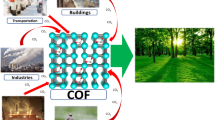Abstract
The present work deals with a density functional theory (DFT) study of porous organic framework materials containing – groups for CO2 capture. In this study, first principle calculations were performed for CO2 adsorption using N-containing covalent organic framework (COFs) models. Ab initio and DFT-based methods were used to characterize the N-containing porous model system based on their interaction energies upon complexing with CO2 and nitrogen gas. Binding energies (BEs) of CO2 and N2 molecules with the polymer framework were calculated with DFT methods. Hybrid B3LYP and second order MP2 methods combined with of Pople 6-31G(d,p) and correlation consistent basis sets cc-pVDZ, cc-pVTZ and aug-ccVDZ were used to calculate BEs. The effect of linker groups in the designed covalent organic framework model system on the CO2 and N2 interactions was studied using quantum calculations.






Similar content being viewed by others
References
Li JR, Ma Y, McCarthy MC et al (2011) Carbon dioxide capture-related gas adsorption and separation in metal-organic frameworks. Coord Chem Rev 255(15-16):1791–1823
Raftery AE, Zimmer A, Frierson DMW, Startz R, Liu P (2017) Less than 2°C warming by 2100 unlikely. Nat Clim Chang 7:637
Li L, Zhao N, Wei W, Sun Y (2013) A review of research progress on CO2 capture, storage, and utilization in Chinese Academy of Sciences. Fuel 108:112–130
Hedin N, Chen L, Laaksonen A (2010) Sorbents for CO2 capture from flue gas-aspects from materials and theoretical chemistry. Nano 2(10):1819–1841
Plasynski SI, Chen Z-Y (1997) Review of CO2 capture technologjes and some improvement. https://web.anl.gov/PCS/acsfuel/preprint%20archive/Files/Volumes/Vol45-4.pdf, pp 644–649
Sumida K, Rogow DL, Mason JA et al (2012) Carbon dioxide capture in metal-organic frameworks. Chem Rev 112:724–781
Lee SY, Park SJ (2015) A review on solid adsorbents for carbon dioxide capture. J Ind Eng Chem 23:1–11
Patel HA, Je SH, Park J et al (2013) Unprecedented high-temperature CO2 selectivity in N2-phobic nanoporous covalent organic polymers. Nat Commun 4:1357
Ding S-Y, Wang W (2013) Covalent organic frameworks (COFs): from design to applications. Chem Soc Rev 42(2):548–568
Yao S, Yang X, Yu M, Zhang Y, Jiang J-X (2014) High surface area hypercrosslinked microporous organic polymer networks based on tetraphenylethylene for CO2 capture. J Mater Chem A 2(21):8054
Cazorla C (2015) The role of density functional theory methods in the prediction of nanostructured gas-adsorbent materials. Coord Chem Rev 300:142–163
Frisch MJ, Trucks GW, Schlegel HB et al (2004) Revision C.03. Gaussian Inc., Wallingford
Becke AD (1993) A new mixing of Hartree–Fock and local density-functional theories. J Chem Phys 98(2):1372
Lee C, Yang W, Parr RG (1988) Development of the Colle-Salvetti correlation-energy formula into a functional of the electron density. Phys Rev B 37(2):785–789
Altarawneh S, Behera S, Jena P, El-Kaderi HM (2014) New insights into carbon dioxide interactions with benzimidazole-linked polymers. Chem Commun 50(27):3571
Vogiatzis KD, Mavrandonakis A, Klopper W, Froudakis GE (2009) Ab initio study of the interactions between CO2 and N-containing organic heterocycles. ChemPhysChem 10(2):374–383
Patel HA, Je SH, Park J, Jung Y, Coskun A, Yavuz CT (2014) Directing the structural features of N2-phobic nanoporous covalent organic polymers for CO2 capture and separation. Chemistry 20(3):772–780
Lu J, Zhang J (2014) Facile synthesis of azo-linked porous organic frameworks via reductive homocoupling for selective CO2 capture. J Mater Chem A 63:2144–2151
Patel HA, Karadas F, Byun J et al (2013) Highly stable nanoporous sulfur-bridged covalent organic polymers for carbon dioxide removal. Adv Funct Mater 23(18):2270–2276
Bhunia A, Boldog I, Moller A, Janiak C (2013) Highly stable nanoporous covalent triazine-based frameworks with an adamantane core for carbon dioxide sorption and separation. J Mater Chem A 1(47):14990–14999
Ben-Mansour R, Habib MA, Bamidele OE et al (2016) Carbon capture by physical adsorption: materials, experimental investigations and numerical modeling and simulations—a review. Appl Energy 161:225–255
Feng X, Ding X, Jiang D (2012) Covalent organic frameworks. Chem Soc Rev 41(18):6010–6022
Acknowledgments
The author gratefully acknowledges the contribution of Dr. Swagat Rath in providing valuable input. This research work was performed using the supercomputer cluster facility present in Council of Scientific and Industrial Research (CSIR) Center for Mathematical Modeling and Computer Simulation (C-MMACS) located in the National Aeronautics Laboratory (NAL) campus, Bangalore, India, sponsored by the Ministry of Science, India.
Author information
Authors and Affiliations
Corresponding author
Rights and permissions
About this article
Cite this article
Dash, B. Carbon dioxide capture using covalent organic frameworks (COFs) type material—a theoretical investigation. J Mol Model 24, 120 (2018). https://doi.org/10.1007/s00894-018-3646-3
Received:
Accepted:
Published:
DOI: https://doi.org/10.1007/s00894-018-3646-3




